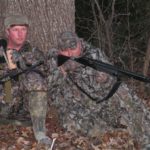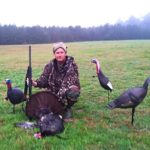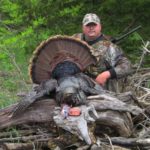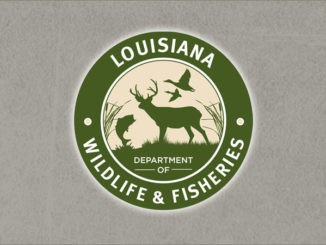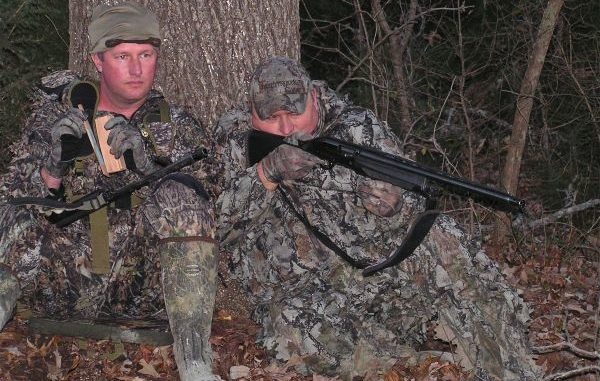
This Union Parish team knows how to track down and kill gobblers. Here’s how they work together to outsmart wily old toms.
When people get married, their love forms a “perfect union.” It’s like our founding fathers planned for America, as in a more “perfect union” in the Preamble to our Constitution.
But this story is about another perfect union — the long-standing friendship between hunting partners Peyton McKinnie and Nathan Pilgreen, who have been hunting together since they were young enough to get their first BB guns and go afield.
McKinnie and Pilgreen enjoy just about anything outdoors, but they love turkey hunting the most. McKinnie, a sheriff’s deputy, lives in Marion and Pilgreen, an AT&T employee, lives in nearby Dean, both in Union Parish.
Union Parish is also always among the top three or four parishes in the state for harvesting turkeys.
It hasn’t always been that way.
As McKinnie and Pilgreen were growing up, there wasn’t even a turkey season.
In 1996, they attended a National Wild Turkey Federation banquet in Farmerville. There weren’t many others there, and they were the youngest. They both won big bundles of turkey hunting door prizes.
Pilgreen had a friend with a spot in a small area of the parish that opened for turkeys, and he killed his first turkey there.
The next spring, McKinnie joined him for the first time and they both got gobblers.
With the help of a few old timers like Joe Pickle and Jerry Antley, they learned turkeys and were hooked.
Now, at 40 years of age, they are both still hooked.
“It’s hard to explain our love for turkey,” Pilgreen said. “I think it kind of defines what Mother Nature is. In the real outdoors world, hens cluck and yelp, and go to the gobbler when he calls. Sometimes the gobblers go to the hens.
“What we do is imitate the hens and bring him to us. It’s the way Mother Nature works. We just imitate it.”
His hunting style is aggressive.
“I call hard, even sometimes when the turkey is right there in gun range,” Pilgreen says. “I’d recommend other people try that, too: Not only does it get the gobbler even closer, it makes him be more aggressive and really put on a show.
“That’s one thing I love about turkey hunting.”
The team recommends learning how to call with a box or slate call because those are the easiest to use.
And, while they were taught by the old timers because that was the only way, today’s new hunters can watch countless videos on the Internet about how to call and when to call. As they say, a picture is worth a thousand words and a video is even better.
A diaphragm, or mouth call, takes you one more step up the ladder of success, though. You can use it to call and keep your hands free for hunting.
That also helps you remain still, which Pilgreen said is essential.
“Look, if a turkey could smell, nobody would ever kill one,” he said. “They can see better than anything else in the woods, and if they could smell you, too, game over.
“Being still is key. Not just when you see turkeys, but anytime they are near. Sometimes they let you know where they are all the time; sometimes you just look up and here they come. But if you move, that’s gone.”
So how would they recommend others get in on this fun?
“It takes a lot of time finding good places to hunt and learning those places,” Pilgreen said. “You can’t just go out in the woods and call turkeys and have them come to you. You have to scout, find where the turkeys are and where they are going and know your terrain. Then set up properly to get them to you.
“You have to remember, too, that turkeys will move. Really, when you do all that, calling is the least of your worries.”
Scouting for turkeys simply means spending time in the woods looking for them. You can find where turkeys roost early and late by using an owl or crow call.
“For some reason, if you use that call and a turkey is in the area, he’ll gobble back at you,” he said. “You find where he is and where he’s going.”
But knowing how to properly set up means knowing the turkey’s home well.
“Being an expert woodsman for the area you are hunting is essential to be consistent,” Pilgreen says. “Know the habitat. Know the roosting areas and the feeding areas, as well as where they like to get out and strut.
“It’s not just about finding them, but finding where they want to go.”
That also means knowing the habitat between you and the turkeys. One of the biggest mistakes turkey hunters make is finding turkeys, and then setting up in the wrong place.
If there is a thick area between you and them, for instance, the birds aren’t going to come through it.
“Turkeys can’t navigate through a pine thicket or a wooded area that is hard to get through, and no matter how good you can call they just won’t come through it,” McKinnie said. “They like open areas where they can see what’s going on and feel safe.
“A turkey has to run to get away from predators, and they can’t run in a pine thicket or in overgrown brush. They can fly short distances, but they only do that in emergencies or going to or from the roost normally.”
So it’s best to ensure the route you want a bird to take is unobstructed.
“In all my years of hunting, I’ve only had one exception to that,” Pilgreen recalled. “We were hunting on one side of DeLoutre Creek and a turkey was gobbling like crazy on the other side. We had heard it several trips.
“One day I was able to call him enough to get him to fly about 50 yards over the creek and basin. He came right to us.”
McKinnie laughed at the memory.
“He’s the only one I know that could do that,” he said.
Turkey hunting cab be the toughest kind of hunting out there. But when you get the hang of it, it’s on like Donkey Kong.
“There’s nothing like it,” says Pilgreen. “When you first take somebody and they hear the turkeys, then see them get into gun range, nine times of 10 they’ll be shaking so bad they can hardly shoot.
“That pretty much says it all.”
